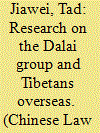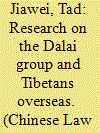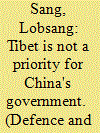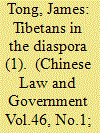|
|
|
Sort Order |
|
|
|
Items / Page
|
|
|
|
|
|
|
| Srl | Item |
| 1 |
ID:
129255


|
|
|
|
|
| Publication |
2013.
|
| Summary/Abstract |
The Dalai Lama's scheme to leave China was engineered long ago by the imperialists and Tibetan secessionists. Back in the winter of 1950, when there was a scheme for the Dalai Lama to visit Yadong County [on the border with India, tr.], "the U.S. policy was to induce him cross the Indian border . . . in the hope of persuading him to flee to the United States"1orfor him to "seek refuge" in such Buddhist countries as Burma, Thailand, or Sri Lanka. In 1956, taking advantage of the Indian government's invitation for the Dalai Lama to visit India to participate in the 2,500th anniversary of the birth of Sakyamuni, anti-China elements abroad and Tibetan secessionists collaborated in trying to get the Dalai to stay in India, and stated that "the Dalai Lama was welcome to go to the United States." After the armed insurrection in Lhasa in March, 1959, the secessionist clique succeeded in spiriting the Dalai out of China. On March 24, when they arrived at Qiongduojiang in Shannan, the head of the secessionist clique and the Dalai met with the chieftain Kampot Tashi of the "Four Rivers and Six Ranges Defenders of the Faith" and others. It was then that the Dalai andhis entourage started to maintain direct wireless communication with the U.S. Central Intelligence Agency via Wangdu, a special agent trained bythe United States.
|
|
|
|
|
|
|
|
|
|
|
|
|
|
|
|
| 2 |
ID:
129256


|
|
|
|
|
| Publication |
2013.
|
| Summary/Abstract |
The Dalai's father, Choekyong Tsering, was of peasant extraction. Afterthe Dalai mounted the Lion Throne in 1940, his father all at once rose tothe position of a senior aristocrat in Tibet and was poisoned to death in1947 because of his close association with the patriotic Reting Rinpoche.The Dalai's mother Dekyi Tsering was "of a gentle disposition" and"kind-hearted," and in 1959 fled with the Dalai to India, where she diedof an illness in 1981. The Dalai Lama, Tenzin Gyatso, has six brothersand sisters, namely his eldest brother Taktser Thubten Norbu, his secondelder brother Gyalo Thondup, his third elder brother Losang Samten,his elder sister Tsering Dolma, his younger sister Jetsun Pema, and hisyounger brother Ngari Rinpoche Tenzin Cheogyal
|
|
|
|
|
|
|
|
|
|
|
|
|
|
|
|
| 3 |
ID:
129257


|
|
|
|
|
| Publication |
2013.
|
| Summary/Abstract |
In 1956, after the defeat of the armed insurrection launched by the reactionary upper stratum in the Sichuan Ganzi Tibetan Autonomous Prefecture, a number of armed rebels who escaped destruction crossedthe Jinsha River toward the West and fled to various areas in Tibet. Someof them, headed by Andruk-tsang Gonpo Tashi, mustered some remnant bandits from Sichuan, Qinghai, Gansu, and Yunnan provinces and setup an army called Four Rivers and Six Ranges Defenders of the Faith(hereafter, Defenders of the Faith), which was supported and supplied with arms and equipment by anti-China forces in the United States andIndia. In March 1959, the reactionary Tibetan upper stratum launched their all-out counterrevolutionary armed insurrection in Lhasa. The reactionary elements then fled to India, taking along the Dalai by force, together with about 20,000 armed rebels. These, plus about 40,000 Tibetan masses whowere strong-armed into following the Dalai, fled to such places as India, Nepal, Bhutan, and Sikkim. Most of these later assembled in India. For thesake of controlling the armed personnel and stabilizing the social order, the Indian government at the time took over their weapons, detained and screened them, and emplaced them in groups.
|
|
|
|
|
|
|
|
|
|
|
|
|
|
|
|
| 4 |
ID:
129258


|
|
|
|
|
| Publication |
2013.
|
| Summary/Abstract |
The Tibetans are fairly widely distributed in China. Some exist in separate communities, while others live intermixed or in staggered communities with other ethnic groups. As in the past, the Tibetan regions have customarily been divided into three major districts: U-Tsang, Khampa, and Amdo. The historical evolutions of these districts are dissimilar, their levels of development vary, and their languages and customs also differ to varying extents. There are also many sects in Tibetan Buddhism. Where there are differences, there are conflicts. Regional and religious conflicts have existed in the past, and the Tibetans who have fled abroad have set up organizations of varying descriptions to protect the interests of each region and religious sect. This has resulted in the emergence of a vast number of factional organizations. Some of these are of a regional nature; others are social organizations of various types set up with refer- emcee to, or in imitation of, organizations in China and abroad. In this chapter, descriptions will be given only of a few organizations that are relatively influential in the Dalai Clique.
|
|
|
|
|
|
|
|
|
|
|
|
|
|
|
|
| 5 |
ID:
129382


|
|
|
|
|
| Publication |
2012.
|
| Summary/Abstract |
In China don't expect any change even with a new leadership. It is true Xi Jinping's father knew the Dalai Lama and even the Panchen Lama. He had in fact backed China's most liberal premier Hu Yaobang. Whether the father's ideas have influenced the son is not clear. We may or hope to see some change only after the 19th party congress in about five years from now. The present people are in their 60s, people whose minds were shaped in a different era. Also, the system carries on no matter whose in charge. Point to note is that Tibet is not a priority for China's government. How else can you explain Tibet and Tibetans being fed the same medicine even though it's apparent that the medicine is not working.
Immolations have now touched 85. There was one immolation in 2009 but in 2011 it shot up to 23. Match this with the crackdown on Tibetans seeking to enter India through Nepal. The Chinese have sealed close to 75 per cent of the border with Nepal. They have also trained Nepali border guards and are providing food and fuel to Nepali villages near the border to report the presence of any Tibetans in their area. Up to 2008, between 3000-5000 Tibetans used to enter Nepal, now it is down to 1000.
The positive here is that the international community is becoming increasingly vocal about Tibet. After a long time the UN High Commissioner for Human Rights Navi Pillay issued a strong statement on Tibet.
|
|
|
|
|
|
|
|
|
|
|
|
|
|
|
|
| 6 |
ID:
129250


|
|
|
|
|
| Publication |
2013.
|
| Summary/Abstract |
An introduction to the journal is presented which discusses chapters from the book "Research on the Dalai Group and Tibetans Overseas" dealing with demographic composition, social and educational institutions.
Since the Tibetan Rebellion in March 1959, the Dalai Lama and his supporters have established the Tibetan Central Administration as the government-in-exile. Located in the Himalayan foothills and surrounded by dense coniferous forests in the Indian state of Himachal Pradesh, Dharamsala has been the seat of the exiled government and the residenceof the 14th Dalai Lama since May 1960. The 50,000 original Tibetan émigrés have grown to around 120,000, the largest number residing inI ndia as well as in the Himalayan states of Nepal and Bhutan in addition to smaller communities in thirty-eight other countries. This and the following issue are focused on these Tibetans in the Diaspora, including their political organization, economic conditions, military apparatus, demographic composition, and social and educational institutions.
|
|
|
|
|
|
|
|
|
|
|
|
|
|
|
|
|
|
|
|
|